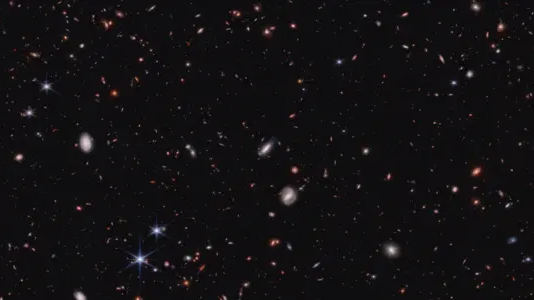James Webb Space Telescope finds galaxies pointing toward a dark matter alternative
"The bottom line is, 'I told you so.'"

A group of astronomers analyzing data from the James Webb Space Telescope (JWST) say some of the oldest galaxies in our universe appear much larger and brighter than expected, suggesting they formed early and grew rapidly — potentially without the influence of dark matter.
According to the researchers, the findings provide new clues that point toward an alternative to dark matter known as modified Newtonian dynamics, or MOND.
"The expectation was that every big galaxy we see in the nearby universe would have started from these itty-bitty pieces," Stacy McGaugh, who is an astrophysicist at the Case Western Reserve University in Ohio, said in a statement. "What the theory of dark matter predicted is not what we see."
The gradual hierarchical evolution of galaxies, which is thought to be driven by cold dark matter and is a crucial component of the standard cosmological model of our universe, is widely accepted because it explains the diverse shapes and sizes of galaxies sprinkled across the cosmos.
Related: Black holes that form in 'reverse Big Bang replays' could account for dark energy
Yet, the JWST has not yet spotted the dim signals expected to emanate from those small, primitive fragments of galaxies in the early universe, McGaugh and his colleagues say. Instead, the telescope's data shows early galaxies were larger and brighter than anticipated, even as the team looked further back in time. The researchers argue that these galaxies grew too big, too quickly — well ahead of expectations set by conventional cold dark matter models.
This rapid growth, however, precisely aligns with the 26-year-old predictions of MOND.
Breaking space news, the latest updates on rocket launches, skywatching events and more!
"The bottom line is, 'I told you so,'" McGaugh said in the statement. "I was raised to think that saying that was rude, but that's the whole point of the scientific method: Make predictions and then check which come true."
Some of the excessively bright sources the JWST recorded could be active supermassive black holes instead of galaxies, the researchers note, but that "does not really help anyway, as it simply turns the problem of too many early stars into one of too many early supermassive black holes."
MOND, which posits that, when it becomes extremely weak, gravity behaves differently from the way Isaac Newton predicted it would. An example of such weakness is at the edges of galaxies. The concept was proposed by Israeli physicist Mordehai Milgrom in 1982 as a way to explain faster-than-expected rotation of galaxies without invoking dark matter or dark energy.
Although MOND has had some success, however, it has quite a few critics. Astronomers find it challenging to integrate the idea into a unifying framework that can explain a wide range of cosmological observations. In contrast, the dark matter paradigm fits many observations but doesn't fully explain phenomena predicted by MOND.
"We find ourselves caught between two very different theories that seem irreconcilable despite applying to closely related yet incommensurate lines of evidence," McGaugh and his colleagues wrote in their paper, which was published Tuesday (Nov. 12) in The Astrophysical Journal.
While MOND is not a widely-accepted theory in cosmology, the researchers are convinced it has made enough successful predictions that it cannot be a mere coincidence.
"It must be telling us something," they note in the paper. "What that is remains as mysterious as the composition of dark matter."

Sharmila Kuthunur is an independent space journalist based in Bengaluru, India. Her work has also appeared in Scientific American, Science, Astronomy and Live Science, among other publications. She holds a master's degree in journalism from Northeastern University in Boston.
